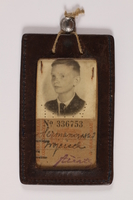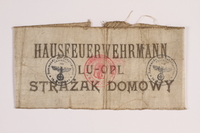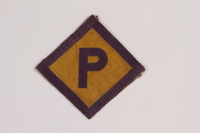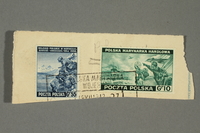Overview
- Description
- The papers consist of documents and photographs relating to the Hermanowski family of Warsaw. Includes Wojciech Hermanowksi's documents referring to his education and slave labor; family photographs, including among them a photograph depicting Wojciech working in a dairy; documents relating to the family's post-war status as displaced persons; and Swedish passport for foreigners.
- Credit Line
- United States Holocaust Memorial Museum Collection, Gift of Wojciech Hermanowski
- Collection Creator
- Hermanowski family
- Biography
-
Jan and Stanislawa Hermanowski, their son Wojciech , and his older brother Andrzej, lived at 32/44 Raszynska Street in Warsaw. Jan was a high official in the city government. After the German occupation of Poland, both boys continued their education. Wojciech was able to do so legally due to his age, and Andrzej studied in an underground high school. After the Warsaw Uprising in August 1944, Wojciech and his parents were deported to a slave labor camp in Wriezen, and later Wojciech was transferred to work at a dairy in nearby Eberswalde. Andrzej was imprisoned in Auschwitz, Neuengamme, Braunschweig and Bergen Belsen. The family was reunited at the end of the war and transferred to Sweden, where they were able to convalesce at a center for refugees.
Physical Details
- Genre/Form
- Passport. Photographs.
- Extent
-
1 folder
Rights & Restrictions
- Conditions on Access
- There are no known restrictions on access to this material.
- Conditions on Use
- Material(s) in this collection may be protected by copyright and/or related rights. You do not require further permission from the Museum to use this material. The user is solely responsible for making a determination as to if and how the material may be used.
Keywords & Subjects
- Topical Term
- Jews--Persecutions--Poland--Warsaw.
Administrative Notes
- Holder of Originals
-
United States Holocaust Memorial Museum
- Legal Status
- Permanent Collection
- Provenance
- The papers were donated to the United States Holocaust Memorial Museum in 2014 by Wojciech Hermanowski.
- Record last modified:
- 2023-02-24 13:44:30
- This page:
- https://collections.ushmm.org/search/catalog/irn106723
Download & Licensing
In-Person Research
- Available for Research
- Plan a Research Visit
-
Request in Shapell Center Reading Room
Bowie, MD
Contact Us
Also in Hermanowski family collection
The collection consists of an armband, a badge, an envelope with commemorative stamps, documents, and photographs relating to the experiences of Wojciech Hermanowksi and his family in Poland, Germany, and Sweden during and after the Holocaust.
Date: approximately 1935-approximately 1946

Public transport pass and identification tag issued to a Roman Catholic Polish youth
Object
Leather tag with an identification card and public transport pass for July 1944, issued to Wojciech Hermanowski. Wojciech was a Roman Catholic boy living with his parents, Jan and Stanislawa, and his older brother, Andrzej, in Warsaw, Poland, when the German army invaded on September 1, 1939. Wojciech was no longer allowed to go to school, so he began attending trade school and took general classes in secret. In February 1943, Andrzej was arrested as part of the underground resistance, and later transported to Auschwitz concentration camp. On August 1, 1944, the city’s underground resistance rose up against the German occupation forces. During the Warsaw Uprising, Wojciech and his parents were deported to a slave labor camp in Wriezen, Germany. Wojciech was then transferred to work at a dairy processing facility in nearby Eberswalde, and later reunited with his parents. From April 23 to May 3, 1945, they were sent on a forced march and then abandoned by the German guards. The family was found by Allied soldiers and were taken to a camp for displaced persons in Lübeck. They were reunited with Andrzej, who was severely ill from imprisonment in Auschwitz, Neungamme, Branschweig and Bergen-Belsen concentration camps. The entire family was transferred to Sweden for recuperation in July 1945, where Wojciech changed his name to Richard. Richard’s parents and brother decided to return to Poland early in 1947. Richard immigrated to the United States in 1954, settling in New York City.

White cloth armband worn by a Roman Catholic Polish firefighter in Warsaw
Object
Firefighter’s armband issued to Wojciech Hermanowski and used during the German occupation of Warsaw. The armband enabled Wojciech to safely go out on the streets, even after curfew, which was dangerous for most Polish residents. Wojciech was a Roman Catholic boy living with his parents, Jan and Stanislawa, and his older brother, Andrzej, in Warsaw, Poland, when the German army invaded on September 1, 1939. Wojciech was no longer allowed to go to school, so he began attending trade school and took general classes in secret. In February 1943, Andrzej was arrested as part of the underground resistance, and later transported to Auschwitz concentration camp. On August 1, 1944, the city’s underground resistance rose up against the German occupation forces. During the Warsaw Uprising, Wojciech and his parents were deported to a slave labor camp in Wriezen, Germany. Wojciech was then transferred to work at a dairy processing facility in nearby Eberswalde, and later reunited with his parents. From April 23 to May 3, 1945, they were sent on a forced march and then abandoned by the German guards. The family was found by Allied soldiers and were taken to a camp for displaced persons in Lübeck. They were reunited with Andrzej, who was severely ill from imprisonment in Auschwitz, Neungamme, Branschweig and Bergen-Belsen concentration camps. The entire family was transferred to Sweden for recuperation in July 1945, where Wojciech changed his name to Richard. Richard’s parents and brother decided to return to Poland early in 1947. Richard immigrated to the United States in 1954, settling in New York City.

Forced labor badge worn by a Roman Catholic Polish youth
Object
Forced labor badge worn by Wojciech Hermanowski, to identify him as a Polish forced laborer in Wriezen and Eberswalde, Germany, near Breslau, between August 1944 and May 1945. Wojciech was a Roman Catholic boy living with his parents, Jan and Stanislawa, and his older brother, Andrzej, in Warsaw, Poland, when the German army invaded on September 1, 1939. Wojciech was no longer allowed to go to school, so he began attending trade school and took general classes in secret. In February 1943, Andrzej was arrested as part of the underground resistance, and later transported to Auschwitz concentration camp. On August 1, 1944, the city’s underground resistance rose up against the German occupation forces. During the Warsaw Uprising, Wojciech and his parents were deported to a slave labor camp in Wriezen, Germany. Wojciech was then transferred to work at a dairy processing facility in nearby Eberswalde, and later reunited with his parents. From April 23 to May 3, 1945, they were sent on a forced march and then abandoned by the German guards. The family was found by Allied soldiers and were taken to a camp for displaced persons in Lübeck. They were reunited with Andrzej, who was severely ill from imprisonment in Auschwitz, Neungamme, Branschweig and Bergen-Belsen concentration camps. The entire family was transferred to Sweden for recuperation in July 1945, where Wojciech changed his name to Richard. Richard’s parents and brother decided to return to Poland early in 1947. Richard immigrated to the United States in 1954, settling in New York City.

Envelope fragment with two stamps acquired by a Roman Catholic Polish youth
Object
Envelope fragment with two stamps issued in 1943 by the Polish government-in-exile, while based in London, England, and acquired by Wojciech Hermanowski. These are two of the eight second-issue stamps, which were only valid in friendly and neutral nations, such as Great Britain. The stamps helped raise money for the Ministry of Finance, and were used as propaganda to remind the public that the Polish military was still fighting, even while their territory was occupied by Germany. Wojciech was a Roman Catholic boy living with his parents, Jan and Stanislawa, and his older brother, Andrzej, in Warsaw, Poland, when the German army invaded on September 1, 1939. Wojciech was no longer allowed to go to school, so he began attending trade school and took general classes in secret. In February 1943, Andrzej was arrested as part of the underground resistance, and later transported to Auschwitz concentration camp. On August 1, 1944, the city’s underground resistance rose up against the German occupation forces. During the Warsaw Uprising, Wojciech and his parents were deported to a slave labor camp in Wriezen, Germany. Wojciech was then transferred to work at a dairy processing facility in nearby Eberswalde, and later reunited with his parents. From April 23 to May 3, 1945, they were sent on a forced march and then abandoned by the German guards. The family was found by Allied soldiers and were taken to a camp for displaced persons in Lübeck. They were reunited with Andrzej, who was severely ill from imprisonment in Auschwitz, Neungamme, Branschweig and Bergen-Belsen concentration camps. The entire family was transferred to Sweden for recuperation in July 1945, where Wojciech changed his name to Richard. Richard’s parents and brother decided to return to Poland early in 1947. Richard immigrated to the United States in 1954, settling in New York City.



